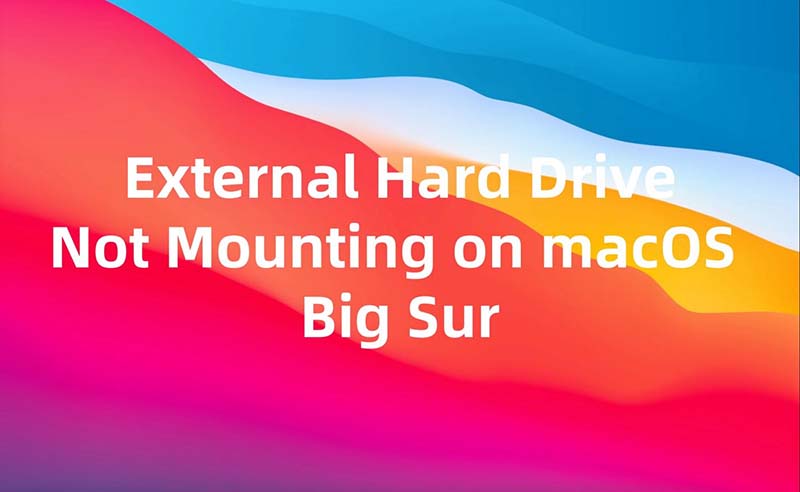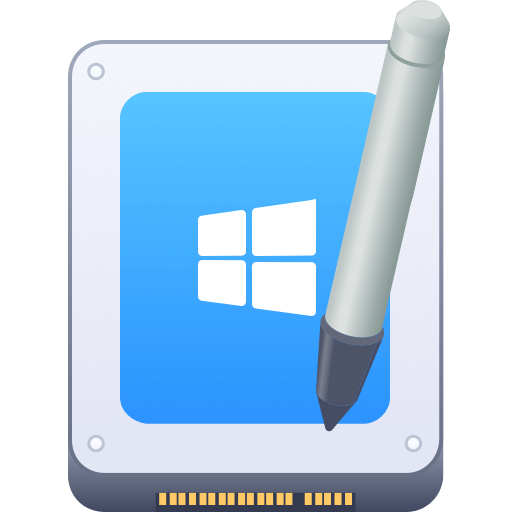Before we start: External hard drives may not mount on macOS Big Sur. Donemax NTFS for Mac tool can help you mount or force mount NTFS external hard drive on Mac and mount other drives on Mac.
PAGE CONTENT:
External hard drives are indispensable tools for backing up data, transferring files, or expanding storage. However, encountering issues where your external hard drive doesn't mount on macOS Big Sur can be frustrating. This article explores why this happens and provides comprehensive solutions to get your drive working again.
The inability to access an external hard drive can stem from multiple factors, ranging from minor connection issues to deeper software or hardware incompatibilities. With macOS Big Sur, some users have reported mounting issues due to system changes or driver limitations. This guide walks you through common causes and practical fixes to resolve the problem efficiently.

Common Reasons Why External Hard Drives Don't Mount on macOS Big Sur
1. Outdated macOS or Compatibility Issues: macOS Big Sur introduced significant updates, which can render older hard drives incompatible. Some drives may require firmware or driver updates to function.
2. Faulty or Damaged Cables/Ports: Loose or damaged cables often disrupt communication between the drive and the Mac. Similarly, malfunctioning USB or Thunderbolt ports can impede detection.
3. File System Incompatibility: If your external hard drive is formatted in a file system not natively supported by macOS (e.g., NTFS without third-party drivers), it may not mount properly.
4. Insufficient Power Supply: Some external drives, particularly older or larger ones, require more power than a single USB port can provide.
5. Disk Corruption or File System Errors: Corrupted file systems or hardware issues can prevent the drive from mounting, even if it’s physically connected.
How to Fix External Hard Drive Not Mounting on macOS Big Sur?
1. Preliminary Checks
Before diving into technical fixes, perform these preliminary checks:
1. Verify Physical Connections
- Check the USB or Thunderbolt cable for any visible damage.
- Ensure the cable is securely plugged into both the Mac and the drive.
- Try connecting to a different port on your Mac.
2. Test on Another Device: Plug the external hard drive into another computer to determine whether the issue is with the drive or your Mac.
3. Use Disk Utility
- Open Disk Utility (search in Spotlight using Command + Space).
- Look for your external hard drive under the External section on the left panel.
- If the drive is visible but greyed out, it means it's recognized but not mounted.
![Use Disk Utility]()
4. Update macOS
- Navigate to System Preferences > Software Update and ensure macOS Big Sur is up to date. Compatibility issues can sometimes be resolved with the latest updates.
![Update macOS]()
2. Use Disk Utility
Disk Utility is the go-to tool for managing and troubleshooting storage devices on macOS. If your external drive isn't mounting, Disk Utility can help identify and fix common problems.
Steps to Mount the Drive:
- Open Disk Utility. You can find it by searching for it using Spotlight (Command + Space) or in Applications > Utilities > Disk Utility.
- Look for your external drive in the left panel. Drives connected to your Mac will appear under the Internal or External sections.
- If your drive appears greyed out, click on it and select the Mount option at the top.
![Steps to Mount the Drive]()
If successful, the drive will immediately appear in Finder and on your desktop.
What If It Doesn't Mount? If clicking Mount doesn't work, the issue may involve file system errors or disk corruption. You can run the First Aid function:
- With your external drive selected, click First Aid at the top of the window.
![click First Aid at the top of the window]()
- Follow the on-screen instructions. First Aid will check for disk errors and attempt to fix them.
- If First Aid completes successfully, try mounting the drive again.
When First Aid Fails: If First Aid reports that the disk cannot be repaired, consider backing up your data using recovery tools (such as Donemax Data Recovery for Mac) and reformatting the drive.
Step 1. Download and install the reliable Mac data recovery software - Donemax Data Recovery for Mac.
Step 2. Open Donemax Data Recovery for Mac, select the unmounted external hard drive to start data recovery.

Step 3. Click on Scan button to deeply scan the unmounted external hard drive and find all recoverable files including the existing files, deleted/erased files, etc.

Step 4. Once the scan is completed, select the wanted files, click on Recover button. Then choose a safe location to save the recovered files.

3. Use Terminal Commands
Terminal allows you to perform advanced troubleshooting when Disk Utility doesn't resolve the issue. With just a few commands, you can manually attempt to mount your external drive.
Steps to Identify and Mount the Drive via Terminal:
- Open Terminal (search in Spotlight or go to Applications > Utilities > Terminal).
- Type the following command and press Enter:
diskutil list
![Use Terminal Commands]()
This command lists all connected drives, including internal and external ones.
- Locate your external hard drive in the list. It will have an identifier like /dev/disk4. Take note of this identifier.
- Use the following command to mount the drive:
diskutil mountDisk /dev/disk4
![Use Terminal Commands]()
Replace /dev/disk4 with the identifier of your drive.
If Mounting Fails:
- You might encounter an error if the file system is corrupted or unsupported. In such cases, you may need to repair or reformat the drive.
- For a more forceful approach, you can unmount and remount the drive using these commands:
diskutil unmountDisk /dev/disk4
diskutil mountDisk /dev/disk4
Checking System Logs for Errors: If you want to dig deeper into what's preventing the drive from mounting, check macOS system logs:
log show --predicate 'eventMessage contains "disk"' --info
This command displays disk-related logs, which can give insights into the issue.
4. Check Drive Format
The file system of an external hard drive determines how it interacts with macOS. Common formats include:
- APFS (Apple File System): Optimized for macOS and works natively with Big Sur.
- HFS+ (Mac OS Extended): Legacy macOS format, also supported.
- ExFAT: Compatible with both macOS and Windows, ideal for cross-platform use.
- NTFS: Windows-native format, which macOS can only read unless third-party drivers are installed.
Steps to Check Your Drive's Format:
- Open Disk Utility.
- Select your external drive from the left panel.
- Look under the drive's details section to find its format.
Reformatting the Drive (If Necessary): If your drive is in an incompatible format or is corrupted:
- Back up your data first, as reformatting erases everything.
- In Disk Utility, select the drive and click Erase.
- Choose a compatible format:
- Use APFS or Mac OS Extended (Journaled) if the drive is for macOS only.
- Use ExFAT for compatibility with both macOS and Windows.
![Reformatting the Drive]()
- Click Erase to complete the process.
Using Third-Party Tools for NTFS Drives: If your external drive is formatted as NTFS and you don't want to reformat:
Step 1. Download and install the best NTFS driver - Donemax NTFS for Mac.
Step 2. Open Donemax NTFS for Mac, select the NTFS drive, click on Enable Writable button.

Then you can mount the NTFS drive and write data to it without any limitation.
5. Reset the SMC (System Management Controller)
The SMC manages various hardware functions on your Mac, including power delivery to USB ports. Resetting the SMC can resolve issues where the drive isn't receiving enough power to function.
Steps for Macs with Apple Silicon: For Macs with the M chips, the process is straightforward:
- Shut down your Mac completely.
- Wait for about 10 seconds to let the system reset itself.
- Restart your Mac and reconnect the external drive.
Steps for Intel-based Macs:
- Shut down your Mac.
- Unplug the power cable (for desktop Macs) or disconnect the battery (for laptops with removable batteries).
- Hold down Shift + Control + Option on the left side of the keyboard, along with the power button, for 10 seconds.
- Release all keys and turn the Mac back on.
6. Updating or Reinstalling Drivers
If the external drive relies on specific drivers, outdated or missing drivers could be causing the problem.
Steps to Update Drivers:
- Identify the brand and model of your external drive.
- Visit the manufacturer's website and look for the support or downloads section.
- Download and install the latest driver updates compatible with macOS Big Sur.
Checking for macOS Updates: Sometimes, driver issues can be resolved by updating macOS itself. Go to System Preferences > Software Update and install any available updates.
Third-Party Software for Legacy Drives: For older drives or unsupported formats, tools like MacFUSE or manufacturer-specific utilities may be required.
Next Steps If All Else Fails: If none of the above solutions work, consider contacting the drive's manufacturer for professional support. They may offer firmware updates or additional troubleshooting steps.
Preventive Tips
Avoid future issues with these best practices:
- Regularly Update macOS: Ensure macOS and any relevant drivers are always up to date to maintain compatibility.
- Use macOS-Compatible Formats: When formatting drives, choose formats like APFS or ExFAT that macOS natively supports.
- Backup Your Data: Always maintain backups to avoid data loss in case of drive failure. Consider using Time Machine for automatic backups.
- Handle External Drives Carefully: Unplug external drives safely by ejecting them first. Avoid force-removing them while data is being written.
Conclusion
An external hard drive not mounting on macOS Big Sur can be resolved by systematically addressing potential issues. From checking physical connections to using Disk Utility and Terminal, there are numerous ways to troubleshoot the problem. If all else fails, consider advanced options like Safe Mode, Recovery Mode, or third-party tools.
If your external hard drive still doesn't mount after trying these solutions, the problem might lie with the hardware itself. Consult a professional or contact the manufacturer for support.


Donemax NTFS for Mac
An easy-to-use NTFS for Mac tool to help you enable writable for NTFS drives on Mac so that you can read-write NTFS drives on Mac without any limitation. It also can help you mount, format, repair, rename, open drive on your Mac.
Related Articles
- Aug 21, 2023How to Fix Toshiba External Hard Drive Not Showing Up?
- Jan 14, 20256 Fixes for Fixing Disk Utility Can't Recognize My Seagate External Hard Drive
- Oct 29, 2024Fix Error Code 102 on Mac: A Comprehensive Guide to Fix It
- Nov 29, 2024Disk Utility Partition Tab Greyed Out: Fix It Now
- Mar 17, 20258 Solutions to Fix Seagate One Touch External Hard Drive Not Working on Mac
- Jul 02, 2024Cannot Format Samsung SSD? Fix It Now

Steven
Steven has been a senior writer & editor of Donemax software since 2020. He's a super nerd and can't imagine the life without a computer. Over 6 years of experience of writing technical solutions and software tesing, he is passionate about providing solutions and tips for Windows and Mac users.

Gerhard Chou
In order to effectively solve the problems for our customers, every article and troubleshooting solution published on our website has been strictly tested and practiced. Our editors love researching and using computers and testing software, and are willing to help computer users with their problems
Hot Donemax Products

Clone hard drive with advanced clone technology or create bootable clone for Windows/Mac OS.

Completely and easily recover deleted, formatted, hidden or lost files from hard drive and external storage device.

Certified data erasure software - permanently erase data before selling or donating your disk or any digital device.






